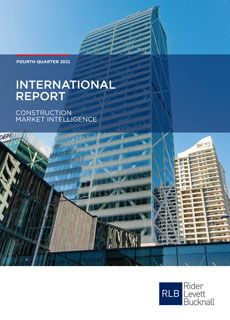According to Rider Levett Bucknall’s (RLB) 4th Quarter 2021 International Report, global construction market activity seems positive as economies appear to return to pre-pandemic volumes.
RLB Global Chairman, Mr Kenneth Kwan said, “As we near two years since the outbreak of the COVID-19 pandemic, construction economies across developed nations appear to be returning to pre-pandemic volumes. The tremendous success of COVID-19 vaccines has allowed economies to reopen, without achieving herd immunity thresholds.”
“Most countries are now implementing sustainable solutions as they learn to live with the virus. As we see more countries avoiding lockdowns and borders re-opening, the prospect of a snap-back recovery in 2022 is looking more positive,” he added.
Economies recovering in different ways
The advent of successive waves of viral infection has resulted in varying economic recovery shapes. Some economies show a V-shape recovery, while others more closely resemble a W shape. In other economies, where multiple lockdowns and re-openings have been experienced, a saw-tooth profile is evident.
Regardless of which recovery profile exists, the overall outcome is one of recovery, with workload increases attributable to economic stimulus packages. That said, the global building and construction industry is not out of danger just yet. The possibility of further waves of COVID-19 variants is ever present, particularly with low vaccination rates in specific regions and the re-commencement of international travel. All these factors could still impact on recovery measures well into 2022.
The RLB Market Sector Activity survey displays mixed results for some sectors. Those sectors heavily impacted by the pandemic remain generally subdued across most regions, particularly offices, hotels and retail.
Rise in market activity is coupled with increased construction costs
Within the RLB network, the general sentiment is that market activity is positive. Sectors across the globe are reporting more than a 10% rise, moving from the decline phase into the growth phase. This rise is clear in the Market Sector Activity survey (full details on page 6). This positive sentiment is coupled with a general increase in construction costs. Almost all RLB offices are reporting higher construction costs through 2021 and into 2022 when compared with figures reported six months ago. The common issues causing these increases in tender prices are shortages of labour, higher construction material prices, and increased activity.
Mr Kwan continued, “In Africa, record low interest rates and the changing paradigm of working in the office versus working from home is causing an uplift in residential activity. Across the Middle East (with the UAE and Qatar the first countries to welcome back international visitors and guests earlier this year), major projects that had been put on hold are starting to fire up again.”
Government spending and funding key to recovery in most countries
“Across Asia, growth in 2021 has been due largely to significant government spending and funding across the public sector. In North America, the residential sector has been key to the overall economic recovery of the region. Similar themes have been observed across the UK, Australia and Europe, with growth assisted by government spending on public sector and infrastructure projects and government incentives for the residential market. New Zealand, which observed a downward trend in activity, is still at relatively high levels compared to a few years prior to the pandemic,” he said.
Global trends observed by RLB offices globally include:
- According to the World Health Organisation (WHO) and leading epidemiologists, the potential of further wave of COVID-19, caused by new variants, is a distinct possibility
- The ongoing trade tensions experienced between China, the USA and others causing global construction material shortages and cost increases
- Higher oil prices are adding pressure to rising inflationary effects
- The ability to achieve consensus on global initiatives to combat climate change at the COP 26 United Nations Climate Change Conference in Glasgow
- The continuing loss of skilled construction workers through both an aging demographic and restrictive borders.
Labour shortages, supply chain issues and higher costs now a worldwide problem
As reported in our previous edition, the same factors are causing the major challenges to the industry across all regions. Labour shortages, supply chain issues and higher costs for materials are not just localised issues but appear as worldwide inhibitors due to the globalisation of both construction supply chains and labour flows across regions.
Generally within the key construction market sectors, RLB sees:
- New single dwelling family homes continue to remain extremely strong
- Commercial construction within the offices, hotels and retail sectors appears to be weaker. These sectors have been impacted by increased reliance on working from home and online shopping
- Social infrastructure and higher levels of renewable energy projects are benefiting from current and future government inputs
- Manufacturing, food, logistics and pharmaceutical related construction is expected to see reasonable growth.
2022 sentiment remains positive but cautious
Mr Kwan concluded, “The impact of the COVID-19 pandemic on labour cannot be overstated. The lack of skilled worker movement across regions has caused significant issues, not only from a cost point of view, but also in terms of productivity. Most regions have reported labour shortages, resulting in pressure to keep pace with the rise in activity.”
“As we look forward into 2022 and beyond, sentiment across regions remains positive but cautious. The general global outlook is for activity to continue its upward trend with costs to follow suit. RLB’s predicted Tender Price Index annual uplifts for 2022 and the remainder of 2021 have generally increased from that forecast six months ago,” he said.
FURTHER INFORMATION:



